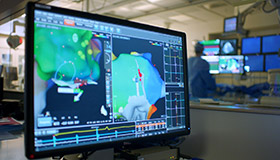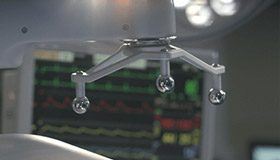Procedure Relieves Young Athlete of Chronic Hip Pain
Experienced orthopaedic surgeon saw beyond the obvious
Allena was referred to Jay Deimel, MD, a board-certified orthopaedic surgeon and director of sports medicine with Allegheny Health Network (AHN). Because of his specialty training and experience treating hip injuries at Stanford University, he was able to quickly assess using physical exam techniques that Allena suffered a soft tissue labral tear. He then confirmed the tear with imaging.
“Allena had been living with a tear of her labrum, which is the soft tissue that surrounds the hip socket and helps keep the hip stable,” said Dr. Deimel. “Because of the looseness of her ligaments, her labral tear caused her to have worsening hip pain which affected her activities.”
Dr. Deimel began treatment with physical therapy (PT). When that didn’t provide relief, he recommended a hip preservation procedure to get her back to full athletic activity. “Patients who continue to experience activity-limiting pain despite a full trial of physical therapy are then considered candidates for hip arthroscopy.”
“Thank goodness I found Dr. Deimel,” said Allena. “He and his physician assistant, Christine Moloney, took one look at how I moved my hip and knew what the problem was. I’d been through more doctors than I can count. To get relief, all I needed was to find the one with the most experience.”
Leading-edge hip surgery personalized to the patient
Hip arthroscopy is an outpatient procedure that uses an arthroscope (a small camera) inserted through a small incision. The camera images are projected onto a large screen so the doctor can visualize the hip joint. Through other tiny incisions, specialized surgical instruments are used to perform surgery to correct the problem. The doctor uses the screen to direct the tools within the joint.
“Hip arthroscopy is a procedure specifically tailored to a patient’s unique hip problem,” said Dr. Deimel. “In Allena’s case, we were able to repair the tear, but also add sutures to her joint capsule because it was loose. The extra sutures help to further stabilize her hip and prevent future injury and pain.”
“I don’t like needles, so I thought I’d be terrified come time for surgery,” said Allena. “But because of how close I was to Dr. Deimel and Christine, I felt safe and wasn’t scared at all.”
Following surgery, Allena spent two weeks on crutches and wore a hip brace to keep the joint stabilized. She then began a rigorous physical therapy program with Jeremy Benson, PT, of Saint Vincent Rehab Solutions. Allena’s physical therapy began the day after her surgery. She would be back to full athletic activity within three months.
“The PT after a hip arthroscopy is in-depth,” said Dr. Deimel. “Patients are required to follow a 10-page instruction manual of what they can and cannot do. With the encouragement of our staff, including her therapist Jeremy Benson, Allena followed instructions perfectly and had great results.”
“Surgery fixed the problem, then PT got me moving again,” said Allena. “After just three months, I was back to going places and cheering again.”
Consult an experienced orthopaedic surgeon when hip pain affects quality of life
“The takeaway is that patients shouldn’t be forced to live in pain for years, or even months,” said Dr. Deimel. “If pain starts to affect your activity level, it’s time to see an expert. Because of the complexity of the hip joint, an accurate diagnosis may be overlooked. I would encourage patients to find a specialist with enough experience so they may start on the road to recovery in a timely fashion.”
Orthopaedic surgeons increasingly perform hip arthroscopy because it is a less invasive approach to solving a physical problem for patients who meet surgical criteria. With arthroscopy, trained surgeons can repair and preserve the hip joint to get patients back to their activities of choice. The tiny incisions allow the patient to recover faster and have less pain.
Dr. Deimel says, on average across the country, patients like Allena may wait 18 months or more to get an accurate diagnosis. He and his team want that to change so patients can get back to their active, fulfilling lifestyles sooner.
“I couldn’t be happier with the care I received from the entire team at the orthopaedic institute,” said Allena. “Without them, I’m honestly not sure where I’d be today. I’m just so thankful to have my life back.”
Contact us
Learn more about orthopaedics in Erie. To schedule an appointment with an AHN orthopaedic surgeon, please call (814) 454-2401 or find a doctor.





